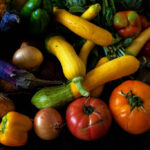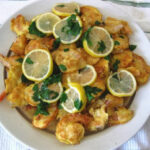I went to Orlando last week! And I’m bringing you more than a tee-shirt!
“Uh-huh,” you’re saying. “And why would anyone in his right mind go to sweltering Orlando in August? It wasn’t for Disney World, was it?”
Uh…no. It wasn’t. It was for the annual conference staged by the Society of Wine Educators (SWE), which brings together a few hundred very serious wine geeks (like me).
Its multiple seminars go much deeper than the usual seminars at gastro-conferences; the attendees are professionals, who know not only their grapes…but they know their yeasts, their bacteria, their fermentation, their…well anything technical that has to do with good ol’ vino.
I was asked to pick out some aspect of food-and-wine matching, and lead a seminar on it. Months before the conference, I flagged this subject: the influence of salt on wine matches for food. I’d been over this ground before, but prepping for this seminar gave me the chance to visit anew this subject…which is a crucial one to master if you want to make good wine choices for your meals!
I started my seminar by outlining my overarching theory about wine with food, first articulated in the book I wrote with Josh Wesson in the late 1980s (“Red Wine with Fish”). Good matching is NOT about the tired “rules” one always hears. Good matching is NOT about color-coding.
Most important, good matching is NOT about lining up corresponding “flavors” in food and wine. How many times have you heard nonsense like this from a “matcher”…
- The presence of raspberries in the sauce for the duck means you have to find a red wine that offers hints of raspberries
- I’ve selected an earthy wine to go with the earthiness of this cheese
- The spiciness of this Sichuan dish leads me to a spicy Gewurztraminer
NONSENSE! Here’s what I think will happen with these matches:
- The dry red wine will be turned to a thin, astringent juice by the raspberries
- If the sommelier has selected an old red Burgundy, known for earthiness…the cheese will wash out its complexity, often making it taste like noxious tobacco
- Because “spicy” and “spicy” have nothing to do with each other, Gewurz (which is often misleadingly described as “spicy”) will throw its bitterness against the “hot” food, leading to disaster.
So what does matter in matching wine with food, you ask?
My answer is simple: components. The things perceived by your tongue in both food and wine: acidity, sweetness, bitterness, saltiness. Add in a few basic wine-specific elements…like alcohol, tannin, and oak…and you cannot go wrong.
So the SWE seminar was a focused look at the component of salt.
Before I launched into the tasting I had prepared, and into the heart of my presentation, I devoted a few very important minutes to Tim Hanni, who this year published a compelling book called “Why You Like the Wine You Like.” Tim has been, over many years, one of the few writers I trust on matching wine with food…and in this book he has even more great observations on the subject.
You’ll have to read the book to get his main gist, but he does finally come around to a process he calls “flavor balancing.” The principles are vastly similar to the ones we’ve both been articulating for years, but Tim takes it a step further. He now says that you should be ready, AT the table, to transform your food so that it better matches the wine you like! Come ready with lemon juice. And come ready with salt (in case the restaurant pretentiously says, “we don’t offer salt because our food is perfectly seasoned”). To take Tim’s most shocking example of “flavor balancing”…he claims that the old rule we all respect, that the fattiness of a good steak smoothes out the rough tannin in red wine…is completely wrong! He says that a steak’s fattiness makes a tannic wine seem MORE tannic!
Then he says that the thing that smoothes out the astringency of tannin…is salt! Simply put more salt on your steak, and your brash, young California Cab will taste milder!
And from there, Tim gives a few general results of salt-on-food usage:
- Makes wine less astringent
- Makes wine (or the food it’s sprinkled on) sweeter
- Makes wine fruitier
I brought all of this up, at my seminar, because I thought that his views might be helpful in solving what I refer to as “The Salt Paradox.”
To me, after many years of observation, the most important thing to know about salt with wine is that salt and alcohol don’t seem to like each other!
If you serve low-alcohol wine with salty food, the match should be seamless.
I demonstrated with a 10% alcohol Vinho Verde, a 9% alcohol Pfalz Riesling…and a whole lotta very salty pretzels (I brought down 150 extra-salty pretzels from Martin’s, the great pretzel-maker in upstate New York).
Next, we tried dry wines that were on the high end of alcohol for the table wine range: a California Sauvignon Blanc that was just over 14% alcohol, and a California Chardonnay that was almost 15% alcohol.
Both were AWFUL with the pretzels, most agreed; the extra alcohol in tandem with the salt seemed to cause an unpleasant bitterness on the palate.
So far, my experiment was working perfectly…and was perfectly reproducible for matchers at home or at restaurants: if you know the food is going to be salty, don’t go much above 12% alcohol on your wine!
But then came the baffling part, which has always puzzled me. When you go above the hot-California alcohol ceiling (above 15%)…something new happens, that makes the high-alcohol wine taste pretty good with the salty food!
I served a dry sherry (16%) with the salty pretzels…recalling the constant matches in Spain of dry sherry with salty food (almonds, olives, ham, cheese).
I also served a Scotch, at 43% alcohol with the salty pretzels…recalling my youth, when I watched my Dad and his buds every weekend enjoy Scotch with peanuts!
And did the liquids work at this tasting?
Yes, but in a weird way. They stepped up to the plate and TANGLED with the salt, creating a thrilling kind of match that wasn’t smooth, but it was good.
What was happening here?
That’s why I brought Tim Hanni into it. Could it be that the palliative functions of salt were coming into play? That salt made the 43% alcohol Scotch seem to have LESS of a bite?
But if that’s so…why didn’t it do that to the 15% Chardonnay? Is it possible that Tim’s salt idea only stands up when there’s a LOT of alcohol?
And that’s where the theory stands, dear reader.
- At 9 or 10% alcohol, salt is golden.
- At 13-14-15% alcohol, you’ve reached the danger zone with salt. Avoid!
- Over 16% alcohol, and all the way up to 43%, expect a wild ride with salt that may actually be pretty good.
I would LOVE to hear your responses to this…or sensory data from any salt-and-wine experiences you’ve had!!!
Image: Society of Wine Educators







